New proposed legislation regarding business interruption coverage may be an economic life raft for small businesses but a significant financial risk to insurance carriers. The insurance industry has been hit with a substantial number of business interruption claims, a large part of which carriers have denied claiming a lack of physical property damage or citing a virus exclusion. The proposed legislation combats the growing economic challenges for small businesses and denial of insurance coverage. The insurance industry has pushed back hard against the legislation arguing that such laws would overwrite private contracts. Proponents of these bills reason that the laws would provide for the creation of funds to reimburse insurers for losses paid by the industry and are another form of government stimulus funding, which utilizes the insurance industry to administer the distribution of those funds.
Although it is unknown whether the proposed legislation will be enacted, it is important to recognize that not all policies need this legislative assistance. Some business interruption policies likely provide business interruption and other types of coverage for COVID-19 related losses under their terms, as written, and the enactment of legislation would not change such coverage.
Which Claims Are Covered under the Proposed Business Interruption Insurance Coverage Legislation?
Legislators in several states, including New Jersey, New York, Massachusetts, Michigan, Ohio, Pennsylvania, Louisiana, and South Carolina, as well as the House of Representatives, have introduced legislation to retroactively compel insurers to cover business interruption claims arising from damages sustained during a period of a declared state of emergency due to COVID-19, and a few bills going so far as including any mutated forms of COVID-19. The proposed bills provide coverage to claims asserted by small businesses, defined in the bills to be businesses with either 250, 150, or 100 and fewer employees. Further, some of the proposed bills expressly address virus exclusions and require insurers to provide coverage despite any virus exclusion provided in a policy.
None of the proposed legislation have yet passed, and most have been referred to the state’s respective insurance or finance committee for review.
Has California Introduced Proposed Legislation?
There is no comparable bill pending in California. However, California’s Insurance Commissioner Ricardo Lara sent a letter to Speaker Nancy Pelosi and California’s Congressional Delegation alerting them about the extent of the business interruption crisis and asking them to take immediate action to protect California’s businesses. To provide state policymakers with more information, Commissioner Lara directed carriers to submit data by April 9, 2020 to the Department of Insurance regarding coverage of commercial business interruption claims related to COVID-19. Commissioner Lara has not provided an update on the data produced by carriers.
Further, and in response to complaints regarding recent and swift denials of business interruption claims, Commissioner Lara issued a notice on April 14, 2020 requiring carriers and other insurance licensees to comply with their contractual, statutory, regulatory, and legal obligations and, importantly, to fairly investigate all business interruption claims related to COVID-19. And, if a carrier denies a claim in its entirety or in part, then the carrier must provide the insured a written explanation of the legal and factual bases for the denial.
Potential Pitfalls of the Proposed Legislation.
The proposed legislation has unsurprisingly come under scrutiny. While many of the proposed bills provide that carriers can apply for reimbursement from state funds made available specifically for this purpose, many critics believe that retroactively forcing coverage will bankrupt the insurance industry. For example, on May 8, 2020, the U.S. Department of Treasury issued a letter to members of Congress stating that such proposals “fundamentally conflict with the contractual nature of insurance obligations and could introduce stability risks to the [insurance] industry.”
In addition to economic considerations, the legislation (if enacted) will have to withstand constitutionality challenges that will certainly be raised by the insurance industry. Carriers can point to the “Contract Clause” (U.S. Const., Art. I, § 10, cl. 1) and Due Process Clauses (U.S. Const., Amends. 5, 14) of the Constitution in support of these challenges. The United States Supreme Court has held that the “Contract Clause” prohibits “substantial impairment” of contractual rights, including for example insurance policies, unless the state has a “significant and legitimate public purpose behind the regulation” and the impairment is reasonable and appropriate as it relates to the public purpose. Similarly, the Supreme Court has held that the Due Process Clauses prohibits such interference with contracts unless “the retroactive application of a statute is supported by a legitimate legislative purpose furthered by rational means.” Whether these legislative measures pass constitutional scrutiny will be very likely be the subject of lengthy litigation.
And while the purpose of the proposed legislation is to provide economic relief to small business, this relief may not arrive in time given the required legislative procedures to enact the proposed bills and lengthy litigation that will inevitably arise from constitutionality challenges. Without the enactment of the proposed legislation, business interruption coverage will depend on the unique circumstances of a business’s loss and the specific terms of the policy.
Things to Consider. . .
Insurance policies have notice provisions requiring insureds to provide timely notice of a claim for coverage. Thus, despite the pending legislation, small businesses can and should file a claim under existing business interruption coverage as soon as possible. Insurance companies may use untimely notice as a basis to deny coverage.
The insured must show that there is a covered loss under the policy. It is important to read the policy and understand what is required to entitle you to coverage Business interruption claims likely require the insured to establish that it has incurred losses stemming from property damage. Policies typically include one of following phrases in describing the type of property damage, the first being most favorable to the insured and the last being the most stringent showing: (1) “direct physical loss of or damage to” the covered property; (2) “direct physical loss or damage to” the covered property; and (3) “direct physical damage to” the covered property.
A common argument by insureds has been that the property damage is a result of the virus proliferating onto every surface and object in, on, and around the covered premises. Another common argument is that the disjunctive use of the provision “direct physical loss of or damage to property” includes coverage for loss of use of the covered property, i.e., physical damage is not required and loss of use of the property is sufficient.
A stronger argument on which to base a claim is if the policy has a provision for damages resulting from governmental action or under a “civil authority” provision. Some “civil authority” provisions provide coverage when a covered loss causes damage to property other than the covered property and the insured sustains a loss of income caused by action of civil authority that prohibits access to the covered premises. Insureds are claiming that the state and local orders shutting down their business and neighboring businesses constitutes property damage because there is a “loss of use” of the business.
In a case pending before the United States District Court, Southern District of New York, Social Life Magazine, Inc. v. Sentinel Insurance Co. Ltd., Case No. 20-cv-3311, the insured sought a preliminary injunction asking the court to order the carrier to provide coverage during the pendency of the underlying action to determine coverage for its business interruption claims related to COVID-19. The carrier opposed the injunction in part by arguing that the insured will not likely succeed in the underlying action because there was no “direct physical loss of or damage to” the premises, which is required under the terms of the policy to be entitled to coverage.
The court denied the insured’s request for an injunction. The court focused on the requirement of “direct physical loss of or damage to” the insured property and held that the language of the policy provided business interruption coverage only where the insured’s property suffered “direct” physical damage. This court’s holding, while telling, is not determinative of the outcome of other claims. Each policy must be reviewed and analyzed to determine whether or not the insured has coverage under its policy.
Once the insured establishes that it has coverage, it is up to the carrier to show that the loss is not covered as a result of, for example, an exclusion in the policy. And, indeed, claims arising from the COVID-19 pandemic have been met with significant pushback from carriers relying on “virus and contamination exclusions” that are included in many policies. These virus exclusions became predominant in 2006, after the Severe Acute Respiratory Syndrome (SARS) epidemic. Here is an example of a virus exclusion:
“We will not pay for loss or damage caused by or resulting from any virus, bacterium, or micro-organism that induces or is capable of inducing physical distress, illness, or disease.”
While the exclusion appears to be all-encompassing, insureds who have policies with the virus exclusion are not out of luck. Many businesses are attempting to overcome the virus exclusion by arguing that the predominant cause of the loss is the civil action—the state and local orders requiring non-essential businesses to shut down or allowing non-essential businesses to operate on a limited basis. Specifically, COVID-19 was first confirmed in the United States on January 20, 2020 and in California on January 26, 2020. Between these dates and through the day before the state and local orders were in effect, businesses were not impacted by the virus and did not experience any losses. However, as of the date of the state and local orders, and as a result of the restrictions, businesses were forced to shut down (or operate on a limited basis) causing the businesses to sustain losses. Thus, businesses are claiming that the government orders are in fact the cause of their loss and, therefore, the virus exclusion should not apply. Carriers will oppose the above argument by contending that the root cause of the loss is a result of the COVID-19 virus and, therefore, the claim is excluded. Stay tuned.
Another safety net for insureds is the inclusion of an applicable endorsement in the policy. Endorsements are typically attached at the end of the policy, which, as a result, has been interpreted by courts to mean that any coverage extended in the endorsement is not excluded by exclusions that are included in the preceding policy pages. For example, if a restaurant (1) has a policy with a virus exclusion, (2) the policy includes a “food contamination” endorsement at the end of the policy, and (3) the restaurant experiences food contamination relating to COVID-19, then the insured can seek coverage under the “food contamination” endorsement despite the virus exclusion.
The final determination of these issues will be subject to lengthy litigation and, again, will depend on the facts of the case and the specific policy language.
For more information visit our COVID-19 Preccelerator Resource Center
https://preccelerator.com/category/covid-19-resources/
Stubbs Alderton & Markiles‘ authors:


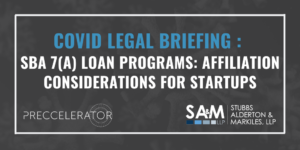 The Coronavirus Aid, Relief, and Economic Security (CARES) Act was recently signed into law, and includes, among other things, a new loan type under the 7(a) loan program of the Small Business Administration (SBA), called the Paycheck Protection Program (PPP). Also available under the SBA framework are
The Coronavirus Aid, Relief, and Economic Security (CARES) Act was recently signed into law, and includes, among other things, a new loan type under the 7(a) loan program of the Small Business Administration (SBA), called the Paycheck Protection Program (PPP). Also available under the SBA framework are 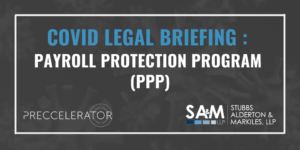 Making payroll is one of the most stressful issues on every business owner’s mind, and thankfully, the Paycheck Protection Program (PPP) section of the CARES Act provides significant aid to provide some financial relief. The final PPP loan application is now available
Making payroll is one of the most stressful issues on every business owner’s mind, and thankfully, the Paycheck Protection Program (PPP) section of the CARES Act provides significant aid to provide some financial relief. The final PPP loan application is now available 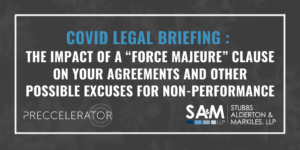 Force Majeure provisions in an agreement may excuse performance by one or both parties to a contract as a result of events that can neither be anticipated nor controlled. These provisions range from simple and boilerplate to extraordinarily detailed. But you may also be excused from performance of a contract if performance of the agreement impossible or impracticable.
Force Majeure provisions in an agreement may excuse performance by one or both parties to a contract as a result of events that can neither be anticipated nor controlled. These provisions range from simple and boilerplate to extraordinarily detailed. But you may also be excused from performance of a contract if performance of the agreement impossible or impracticable.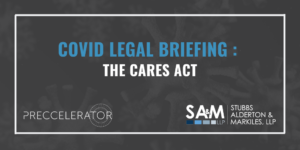 Signed into law on March 27, 2020, The Coronavirus Aid, Relief and Economic Security Act — or “CARES Act”, among other things, provides significant relief for small businesses. The Act injects roughly $2 trillion into the economy for coronavirus relief – providing roughly $350 billion in small business loans and an additional $500 billion in relief to distressed companies in distressed industries, expanding unemployment compensation, and providing rebate checks/tax relief to individuals, families and businesses. This relief is intended to last 3 months.
Signed into law on March 27, 2020, The Coronavirus Aid, Relief and Economic Security Act — or “CARES Act”, among other things, provides significant relief for small businesses. The Act injects roughly $2 trillion into the economy for coronavirus relief – providing roughly $350 billion in small business loans and an additional $500 billion in relief to distressed companies in distressed industries, expanding unemployment compensation, and providing rebate checks/tax relief to individuals, families and businesses. This relief is intended to last 3 months.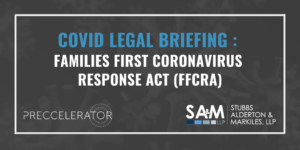 Families First Coronavirus Response Act (FFCRA)
Families First Coronavirus Response Act (FFCRA)